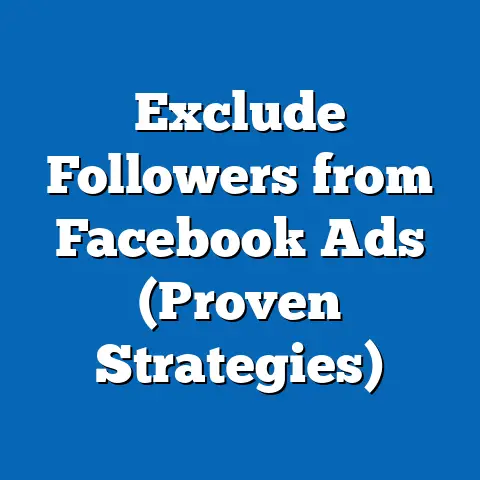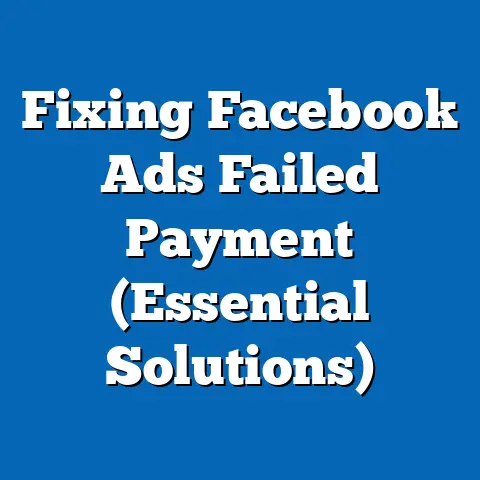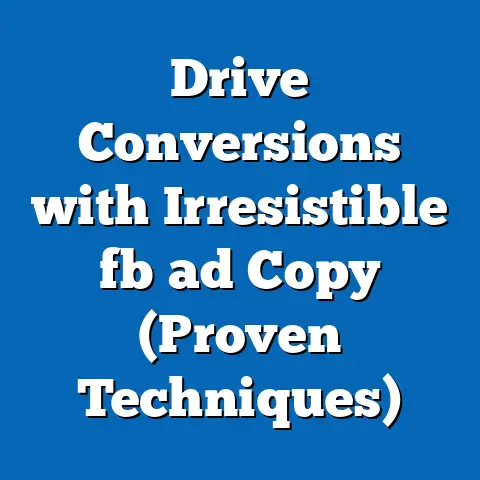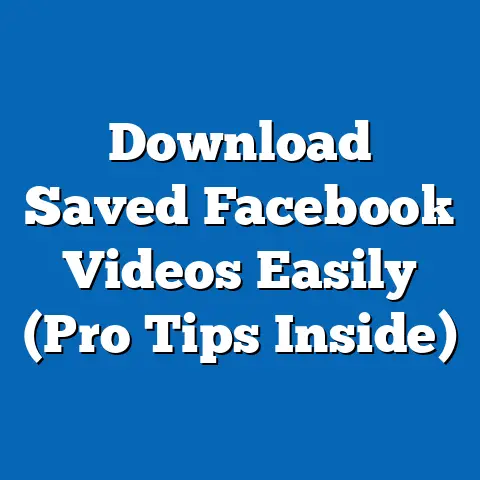Are Instagram Ads Cheaper Than Facebook? (Cost-Effective Insights)
We all find comfort in the familiar, don’t we? In the world of social media advertising, that comfort often translates into sticking with the platforms we know best. For many businesses, that means cozying up with Facebook, the behemoth that’s been a digital marketing staple for years. But is it always the most cost-effective choice? I’ve spent countless hours analyzing ad performance across various platforms, and I’ve seen firsthand how clinging to familiarity can sometimes mean missing out on better ROI elsewhere.
Instagram, Facebook’s younger, visually-driven sibling, often gets overlooked in the budget allocation process. But with its massive user base and highly engaged audience, Instagram presents a compelling alternative. The question then becomes: are Instagram ads actually cheaper than Facebook ads? Or, more importantly, which platform gives you the most bang for your buck?
In this article, I’m going to dissect the cost structures of both Instagram and Facebook advertising, compare their cost-effectiveness, and provide actionable insights to help you make smarter decisions about where to invest your advertising dollars. Forget blindly following the crowd; let’s dive into the data and uncover which platform truly offers the best value for your specific business goals. Get ready to challenge your assumptions and potentially unlock a more profitable path for your social media advertising.
Advertising on Instagram and Facebook: A Quick Overview
Before we get into the nitty-gritty of costs, let’s level-set with a brief overview of advertising on both Instagram and Facebook. While they share the same parent company (Meta), they operate as distinct platforms with unique user demographics, engagement styles, and ad formats.
Facebook: The undisputed king of social media, Facebook boasts a massive and diverse user base, spanning nearly every age group and demographic. This broad reach makes it an attractive option for businesses targeting a wide audience. Facebook’s advertising features are equally robust, offering a wide array of ad formats, from simple image ads to video ads, carousel ads, and lead generation forms. Engagement rates on Facebook, while still significant, are generally lower compared to Instagram. However, the sheer volume of users means that even a lower engagement rate can translate into a substantial number of interactions.
Instagram: Known for its visually-driven content, Instagram attracts a younger, more engaged audience. The platform’s focus on images and videos makes it ideal for brands looking to showcase their products and build a strong visual identity. Instagram offers several ad formats, including Stories ads, Feed ads, Explore ads, and Reels ads, each offering unique opportunities to reach users in different contexts. Engagement rates on Instagram are typically higher than on Facebook, suggesting that users are more receptive to advertising on the platform.
Key Differences in Ad Formats:
- Stories Ads: Short-form video or image ads that appear between user Stories. Highly engaging and ideal for capturing attention quickly.
- Feed Ads: Ads that seamlessly integrate into the user’s main feed, appearing as organic posts. Effective for reaching a broad audience and driving brand awareness.
- Carousel Ads: Ads that allow users to swipe through multiple images or videos within a single ad unit. Great for showcasing a range of products or telling a story.
- Collection Ads: Ads that feature a catalog of products, allowing users to browse and purchase directly from the ad. Perfect for e-commerce businesses.
The evolution of advertising on both platforms has been significant. Over the years, Facebook and Instagram have continuously refined their algorithms, ad placement options, and targeting capabilities. These changes have had a direct impact on advertising costs, as demand for ad space fluctuates based on these factors. For instance, algorithm updates that prioritize user experience can lead to increased competition for prime ad placements, driving up costs. Similarly, new targeting options can make it easier to reach specific audiences, potentially lowering costs by improving ad relevance.
Takeaway: Understanding the nuances of each platform, including their user base, engagement rates, and advertising features, is crucial for determining the most cost-effective advertising strategy.
Understanding the cost structure of Instagram ads is essential for making informed decisions about your advertising budget. Here’s a breakdown of the key metrics and factors that influence the cost of advertising on Instagram:Key Cost Metrics:
- Cost Per Click (CPC): The amount you pay each time someone clicks on your ad.
- Cost Per Impression (CPM): The amount you pay for every 1,000 impressions (times your ad is shown).
- Cost Per Action (CPA): The amount you pay for a specific action, such as a purchase, lead generation, or app install.
Factors Influencing Cost:
- Targeting Options: Instagram’s robust targeting options allow you to reach specific audiences based on demographics, interests, behaviors, and more. The more specific your targeting, the higher the cost per impression or click may be, as you’re competing for a smaller pool of users. However, highly targeted ads can also lead to higher conversion rates, ultimately lowering your cost per acquisition (CPA).
- Ad Relevance Score: Instagram assigns a relevance score to your ads based on how well they resonate with your target audience. Ads with high relevance scores tend to perform better and cost less, as they’re deemed more valuable to users.
- Ad Placement: The placement of your ad can also impact its cost. For example, ads placed in Instagram Stories may have different CPMs than ads placed in the main feed.
- Bidding Strategy: Instagram offers various bidding strategies, including automatic bidding and manual bidding. Automatic bidding allows Instagram to optimize your bids for you, while manual bidding gives you more control over how much you’re willing to pay per click or impression.
- Industry and Competition: The industry you’re in and the level of competition for ad space can also influence costs. Highly competitive industries tend to have higher advertising costs.
Typical Costs on Instagram:
While costs can vary widely depending on the factors mentioned above, here are some general benchmarks to give you an idea of what to expect:
- CPC: $0.50 – $2.00
- CPM: $5 – $10
- CPA: Varies widely depending on the industry and conversion goals
Case Study Example:
I once worked with an e-commerce client selling handmade jewelry. By focusing on a highly specific target audience (women aged 25-45 interested in sustainable fashion and ethical sourcing) and creating visually appealing ads that showcased the unique craftsmanship of their products, we were able to achieve a CPA of just $8 on Instagram. This was significantly lower than their CPA on other platforms, highlighting the power of targeted advertising and compelling creative.
Recent Trends in Pricing:
In recent years, I’ve observed a gradual increase in Instagram ad costs, driven by factors such as increased demand for ad space and changes to Instagram’s algorithm. However, by staying on top of these trends and continuously optimizing your campaigns, you can still achieve a positive ROI on Instagram.
Takeaway: Instagram ad costs are influenced by a variety of factors, including targeting options, ad relevance, ad placement, bidding strategy, and industry competition. By understanding these factors and continuously optimizing your campaigns, you can effectively manage your advertising budget and achieve your desired results.
The Cost Structure of Facebook Ads
Now, let’s turn our attention to Facebook and examine the cost structure of its advertising platform. As with Instagram, understanding the key metrics and factors that influence Facebook ad costs is crucial for maximizing your ROI.
Key Cost Metrics:
- Cost Per Click (CPC): Similar to Instagram, CPC represents the amount you pay each time someone clicks on your ad on Facebook.
- Cost Per Impression (CPM): Also consistent with Instagram, CPM refers to the amount you pay for every 1,000 impressions of your ad on Facebook.
- Cost Per Action (CPA): Again, CPA is the amount you pay for a specific action, such as a purchase, lead generation, or app install, on Facebook.
Factors Influencing Cost:
- Targeting Options: Facebook’s targeting capabilities are incredibly granular, allowing you to reach users based on a wide range of demographics, interests, behaviors, and even custom audiences. The more specific your targeting, the higher the cost per impression or click may be, as you’re competing for a smaller, more defined audience. However, precise targeting can also lead to higher conversion rates and a lower CPA.
- Ad Relevance Score: Facebook also assigns a relevance score to your ads, based on how well they resonate with your target audience. Ads with high relevance scores tend to perform better and cost less, as they’re deemed more valuable to users.
- Ad Placement: Facebook offers a variety of ad placements, including the news feed, right column, instant articles, and Audience Network. The placement you choose can impact your ad costs, as different placements have different levels of visibility and engagement.
- Bidding Strategy: Facebook offers various bidding strategies, including cost per mille (CPM), cost per click (CPC), optimized cost per mille (oCPM), and cost per action (CPA). Your choice of bidding strategy can significantly impact your ad costs and overall campaign performance.
- Industry and Competition: As with Instagram, the industry you’re in and the level of competition for ad space can influence costs on Facebook. Highly competitive industries tend to have higher advertising costs.
- Ad Quality and Creative: The quality of your ad creative (images, videos, and copy) can also impact your ad costs. High-quality, engaging ads tend to perform better and cost less.
Typical Costs on Facebook:
While costs can vary widely depending on the factors mentioned above, here are some general benchmarks to give you an idea of what to expect on Facebook:
- CPC: $0.35 – $1.50
- CPM: $7 – $12
- CPA: Varies widely depending on the industry and conversion goals
Case Study Example:
I recall working with a local restaurant that wanted to increase reservations through Facebook ads. By targeting users within a specific radius of the restaurant and creating visually appealing ads that showcased their menu and ambiance, they were able to achieve a CPA of just $5 per reservation. This was a significant improvement compared to their previous advertising efforts, demonstrating the power of location-based targeting and compelling ad creative on Facebook.
Factors that Contribute to Pricing:
Competition, ad relevance scores, and audience targeting are all major factors that influence the pricing of Facebook ads. The more competition there is for a particular audience, the higher the cost per impression or click will be. Similarly, ads with low relevance scores tend to cost more, as Facebook prioritizes ads that are more likely to resonate with users.
Takeaway: Facebook ad costs are influenced by a complex interplay of factors, including targeting options, ad relevance, ad placement, bidding strategy, industry competition, and ad quality. By understanding these factors and continuously optimizing your campaigns, you can effectively manage your advertising budget and achieve your desired results on Facebook.
Comparing the Cost-Effectiveness of Instagram vs. Facebook Ads
Now for the million-dollar question: which platform offers the best cost-effectiveness – Instagram or Facebook? The answer, as you might suspect, is “it depends.” The ideal platform for your business will depend on a variety of factors, including your target audience, marketing objectives, and budget.
Direct Cost Comparison:
In general, I’ve found that Facebook tends to have slightly lower CPCs than Instagram. This is likely due to the sheer volume of users on Facebook, which creates a larger pool of potential clicks. However, Instagram often boasts higher engagement rates, meaning that users are more likely to interact with your ads on Instagram than on Facebook.
Real-World Examples:
- Example 1: E-commerce Brand Targeting Millennials: An e-commerce brand targeting millennials might find that Instagram is more cost-effective, as this demographic is highly active on the platform and more receptive to visually-driven advertising.
- Example 2: Local Business Targeting a Broad Audience: A local business targeting a broad audience might find that Facebook is more cost-effective, as it offers a wider reach and more granular targeting options.
Impact of Engagement Rates:
Engagement rates play a crucial role in cost-effectiveness. While Facebook may have lower CPCs, Instagram’s higher engagement rates can translate into a better ROI. This is because engaged users are more likely to take action, such as visiting your website, making a purchase, or signing up for your email list.
Which Platform is More Cost-Effective for Different Businesses?
- E-commerce: Instagram is often a great choice for e-commerce businesses, particularly those with visually appealing products.
- Local Businesses: Facebook can be highly effective for local businesses looking to reach customers in their area.
- B2B: LinkedIn may be a better choice for B2B businesses, as it allows you to target professionals based on their job title and industry.
- Brands Targeting Younger Audiences: Instagram and TikTok are often the best platforms for reaching younger audiences.
Expert Opinions:
“Instagram is a great platform for building brand awareness and driving engagement, while Facebook is better for generating leads and driving sales,” says social media marketing expert Neil Patel.
“The key to cost-effective social media advertising is to understand your target audience and choose the platform that best aligns with their interests and behaviors,” adds digital marketing strategist Amy Porterfield.
Takeaway: There’s no one-size-fits-all answer when it comes to cost-effectiveness. The best platform for your business will depend on your specific goals, target audience, and budget. By carefully analyzing the cost structures of both Instagram and Facebook and considering the factors outlined above, you can make informed decisions about where to invest your advertising dollars.
Conclusion and Final Thoughts
So, are Instagram ads cheaper than Facebook ads? The answer, as we’ve explored, is nuanced. While Facebook often offers lower CPCs, Instagram’s higher engagement rates can lead to a better overall ROI for certain businesses and campaigns.
It’s easy to fall into the trap of sticking with what you know, the platform where you feel comfortable. But in the ever-evolving world of social media advertising, comfort can be a costly luxury. By taking the time to understand the unique strengths and weaknesses of each platform, you can make data-driven decisions that maximize your advertising budget and achieve your marketing objectives.
The key takeaway is this: don’t rely on assumptions. Test, analyze, and optimize your campaigns on both Instagram and Facebook to determine which platform delivers the best results for your specific business. The future of social media advertising is all about agility, adaptability, and a willingness to experiment. Embrace the challenge, and you’ll be well on your way to unlocking a more profitable path for your business.






